The K't'inga-class battle cruiser was a primary class of warship in service with the Klingon Imperial Fleet in the 23rd century, and with the Klingon Defense Force in the mid-to-late 24th century.
History

The K't'inga-class cruiser was considered one of the most powerful warships in the Klingon Defense Forces, having entered service in or around 2259, when three ships were sent to destroy a naturally occurring subspace fold. This fold caused the ship's crews to sing after an improbability field emanated from it, which the Klingons found to be dishonorable. (SNW: "Subspace Rhapsody")
By the 2270s the class underwent a reconfiguration which saw the addition of additional armor, and new nacelles. In this year, Station Epsilon IX recorded the destruction of three K't'inga-class vessels by the V'ger entity. (Star Trek: The Motion Picture) Starfleet's interest in the K't'inga-class cruiser was such that in 2285, the class of ship appeared in the Kobayashi Maru scenario at Starfleet Academy. (Star Trek II: The Wrath of Khan)
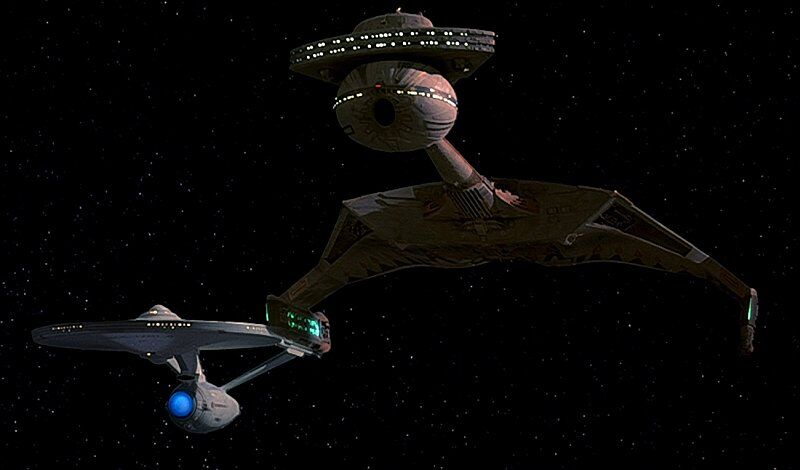
By the 2290s, the K't'inga-class served as a flagship of the Imperial Fleet, with one ship, Kronos One, having carried the Klingon Chancellor to meet the Federation starship USS Enterprise-A, which was to escort it to a peace conference on Earth. (Star Trek VI: The Undiscovered Country)
For nearly a century, the K't'inga-class cruiser proved to be a rugged, sturdy design that saw continuous use. In that aspect they were much like their Federation counterparts the Excelsior-class and Miranda-class starships, whose usefulness outlived contemporaries such as the Constitution II-class cruiser.
With marked improvements, these warships saw continuous use as front-line and border patrol ships throughout the Klingon-Federation War and the Dominion War of the early-2370s. (DS9: "The Way of the Warrior", "Soldiers of the Empire", "Call to Arms") They were not always the ship of choice for all missions, however, as more agile craft like the Klingon Bird-of-Prey were better suited for some tasks. (DS9: "Once More Unto the Breach")
Technical data
The K't'inga-class cruiser was one of the most advanced and versatile warships in the Klingon Imperial Fleet. Although the tactical effectiveness of the K't'inga relative to other ships was never firmly established in true canon, it was capable of challenging a Constitution II-class heavy cruiser without fear (Star Trek VI: The Undiscovered Country), threatening an Excelsior class cruiser in a stand-off situation, and in small numbers it could inflict severe damage on an Excelsior class cruiser (VOY: "Flashback").
Physical arrangement

The outboard plan of the K't'inga design incorporated the same basic shape and classic design lineage dating back over one hundred years to the D5-class battle cruiser. (ENT: "Marauders", et al.) The K't'inga cruiser was a direct offshoot in design-lineage from the venerable D7-class battle cruiser introduced sometime prior to 2267. (TOS: "Errand of Mercy", et al.)
The bulk of the ship's overall mass was incorporated in the aft section of the ship. The bridge module was located on a bulbous forward section, which was separated from the aft section by a relatively thin connective section that attached to and flared into the aft section. Located on the caudal section of the ship were the ship's impulse engines. Jutting from below the port and starboard side of the ship's aft section were the ship's warp nacelles.
Aside from possessing a slightly sleeker shape and contour than its D7-class predecessor, the most notable design variations between the two classes included a less bulbous forward section, a larger bridge dome, differently-designed warp nacelles, and more extensive external hull plating. (Star Trek: The Motion Picture, et al.)
Tactical systems
The weapon systems aboard the K't'inga-class cruisers have included phasers, disruptors, photon torpedo launchers, and concussive charges. (TNG: "The Emissary"; DS9: "The Way of the Warrior"; Star Trek: The Motion Picture; VOY: "Flashback")
The torpedo launchers included one torpedo tube in the forward section, and one aft. The forward torpedo bay was located below the bridge, in the foremost part of the ship, while the aft torpedo bay was located between the impulse engines. During the arming sequence, the interior perimeter of the torpedo tube area glowed a bright red until one or more torpedoes were fired. (Star Trek: The Motion Picture; Star Trek II: The Wrath of Khan; Star Trek VI: The Undiscovered Country)
This class of ship was also equipped with two forward mounted phasers. (TNG: "The Emissary") This phaser and torpedo weaponry was considered state of the art during the 2290s. They were no match for a Galaxy-class starship of the 2360s, but were, however, more than a match for any weakly-defended colony or outpost at the time. (TNG: "The Emissary")
By the late 24th century, K't'inga-class battle cruisers had been retrofitted to keep up with the advances of technology. In the 2370s, their forward torpedo launchers included a powerful disruptor emitter, allowing these vessels to remain formidable adversaries. (DS9: "The Way of the Warrior", "Rules of Engagement")
The red directed energy weapons seen in "The Way of the Warrior" and "Rules of Engagement" were identified as disruptors in the script of "The Way of The Warrior". [1]
Star Trek: Starship Spotter identifies eight and the Star Trek: Deep Space Nine Technical Manual identifies six disruptors on the K't'inga.




Cloaking device
Like many Klingon starships of the time, these vessels also incorporated a cloaking device, which hid them from detection in most evasive situations. (TNG: "The Emissary"; DS9: "The Way of the Warrior")
K't'inga-class cruisers underwent several cloak upgrades during their years of service. Those cruisers equipped with cloaks installed prior to 2290 were known for the particular weakness of not being 100% efficient at blocking gamma radiation. (TNG: "The Emissary")
Propulsion systems
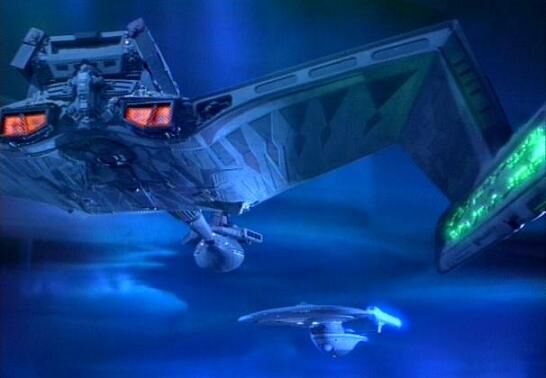
The warp drive of the K't'inga-class enabled it to reach the speed of at least warp 5. (TNG: "Heart of Glory", "The Emissary")
During an encounter between the USS Enterprise-D and the IKS T'Ong, Enterprise chief engineer Geordi La Forge figured that the Enterprise could probably knock out the T'Ong's warp engines without damaging the rest of the ship, as a means of disabling the vessel. (TNG: "The Emissary")
Additional systems
Some K't'inga-class cruisers were equipped with cryonic technology, which allowed crews of the late 23rd century to be placed in cryogenic sleep for long voyages. (TNG: "The Emissary")
Interior design
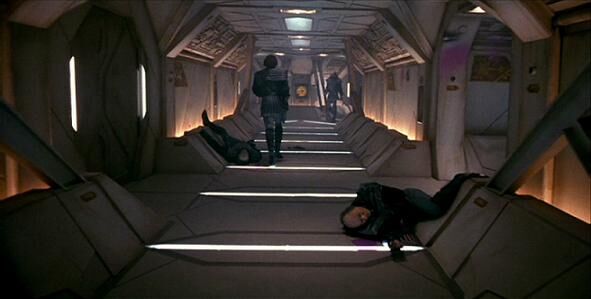
The primary color scheme aboard K't'inga-class cruisers was distinctively earth-tone colors, such as beige and gray.
In contrast to the corridors found aboard contemporary vessels, such as the Bird-of-Prey, these vessels were considerably spacious in size. (Star Trek VI: The Undiscovered Country)
Main bridge
The configuration of the darkened main bridge design of the K't'inga-class cruiser set the tone for many of the later Klingon bridge layouts, including the later Bird-of-Prey and Vor'cha-class cruisers.
The main bridge was located at the top portion of the forward section of the vessel. Located in the front of the bridge, against the forward bulkhead, was the ship's main viewscreen, used by the ship's captain.
Featured in the center of the bridge, on a raised platform directly behind the viewscreen, was the command chair, which could swivel 360 degrees. This position provided the commanding officer an unobstructed view of the screen, as well as allowed the commander to visually monitor all bridge operations.
Directly behind the command chair were two manned consoles. The port side position had control over the viewscreen display and could take the ship into evasive maneuvers (as with helm control on a Constitution II-class ship). Lastly, at the rear of the bridge were two pivoting weapons _targeting stations, which contained the ship's _targeting systems. (Star Trek: The Motion Picture)
Andrew Probert's conceptualization of what lurked beneath the battle cruiser's oddly-shaped bridge helped set the Klingon style for all the Star Trek productions to follow. According to the text commentary by Mike Okuda in the director's edition of Star Trek: The Motion Picture, the Klingon interiors were intended to be "a contrast to the clean, sleek Enterprise interiors seen later" in the movie.
An alternate bridge style was also used on ships by the early 2360s. It featured the captain's chair at the back of a smokey and dimly lit bridge with banners of the Federation and Klingon Empire on the rear wall. (TNG: "Heart of Glory")
Transporter room

The transporter room aboard a K't'inga-class cruiser contained five transporter pads, arranged linearly.
At an angle, and to the right of the pads, was the transporter control console, with an operator's chair; to the left was the doorway. (Star Trek VI: The Undiscovered Country)
The transporter room was a repainted set borrowed from The Next Generation. (Charting the Undiscovered Country: The Making of Trek VI, p. 59)
Stateroom

The stateroom aboard the Kronos One was the Klingon Chancellor Gorkon's private dining and conference room. This room featured a large transparent pedestal-table, with an overhead chandelier, set on a raised platform with surrounding chairs. (Star Trek VI: The Undiscovered Country)
The appearance of stateroom was designed to accommodate the wirework that was used for the filming of the anti-gravity scene. According to cinematographer Hiro Narita, "I knew that the plainer the wall, the more noticeable the wires would appear against it, so I suggested that by darkening the wall and adding a pattern to it, we could create enough visual confusion that the camera might not see the wires." (Charting the Undiscovered Country: The Making of Trek VI, p. 61)
Ships commissioned
- Named
- Uncertain
- Unnamed, by commander
- Unnamed
Appendices
Appearances
- Star Trek films:
- TNG:
- "Heart of Glory"
- "The Emissary"
- "Booby Trap" (desktop model)
- "Unification I"
- DS9:
- VOY:
- PIC:
- "The Bounty"
- "Vox"
- SNW:
Background information
Origins
In the Star Trek: Phase II script "In Thy Image", written by Harold Livingston, the three Klingon warships were identified as Koro-class. They were later changed to K't'inga-class in Gene Roddenberry's novelization of Star Trek: The Motion Picture.
Although this designation was never referenced in any on-screen displays or dialogue, it was adopted by the Star Trek Encyclopedia, 4th ed., vol. 1, p. 397, where it was referred to as a "conjectural designation." Nevertheless, the designation had been recognized by the production staff as this design's name. The class name was canonized in the episode "Subspace Rhapsody".
This class might possibly have been named after the star K't'inga.
Studio model
- See K't'inga-class model.
Interior sets
The movies Star Trek: The Motion Picture and Star Trek: The Undiscovered Country were the only ones that had featured interiors of the K't'inga-class cruiser – the only glimpses afforded into one of the oldest, yet most unexplored designs featured on Star Trek.
Bridge
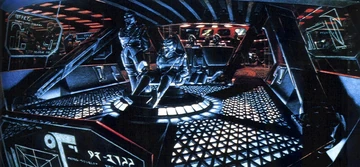 | |
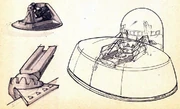 |
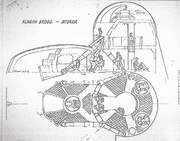 |
In the words of The Motion Picture's special photographic effects director, Douglas Trumbull, the Klingon battle cruiser interior should look like "an enemy submarine in World War II that's been out at sea for too long." (Star Trek: The Motion Picture (The Director's Edition)) Production Illustrator Andrew Probert recalled, "Doug wanted something like the interior of a Japanese submarine; he wanted a bridge suspended between big shock-absorbing supports, with mechanically operating stations for the crewmen. For my own guidance, I worked up a sketch showing the orientation of the bridge within the shape of the ship. I came up with a design that apparently everybody was happy with, and Doug brought in an art director for the construction of the Klingon bridge-who added some outstanding ideas of his own. In my humble opinion, the Klingon bridge is the most exciting set in the movie."(Starlog, No.32, March 1980, p.63)
The bridge had actually been designed thrice. The first 1977 version was done by Art Director Joseph R. Jennings for the movie's direct predecessor, Star Trek: Phase II. Director Robert Wise discarded this version as unsuitable for a theatrical feature, and had a new bridge designed by Jennings' successors, Production Designer Harold Michelson and Art Director Leon Harris, starting in March 1978. (The Making of Star Trek: The Motion Picture, pp. 85, 87) In turn, their version was discarded almost exactly one year later by Trumbull, who, together with Probert, redesigned the bridge for a third and final time. Set construction was farmed out to newcomer and novice Art Director John Vallone, handpicked by Trumbull himself. Because of the re-redesign process and the subsequent set construction on the combined Paramount Stages 12 and 14, filming of the Klingon bridge scenes, originally slated for March 1979, was delayed by nearly three months, only to start on 18 June. Set co-worker, Graphics Designer Lee Cole, has credited Vallone for being very daring and innovative, especially pleased by his introduction of the then yet unproven edge-lit plastic displays and the fiber opticts lighting, which according to Cole "were fabulously successful, beyond our wildest dreams". (Return to Tomorrow - The Filming of Star Trek: The Motion Picture, pp. 345-346, 375)
It was only in The Motion Picture that the K't'inga-class cruiser bridge was featured, as it did not appear in The Undiscovered Country.
Technical Manual
The following information of specifications and defenses comes exclusively from the Star Trek: Deep Space Nine Technical Manual:
- Production Base: Qo'noS Orbital Factory Base
- Type: Heavy Cruiser
- Accommodation: 800 plus flight crew and troops
- Power Plant: One M/A warp system; two impulse systems
- Dimensions: Length, 349.54 meters; beam, 251.76 meters; height, 98.41 meters
- Mass: 760,000 metric tonnes
- Performance: Warp 9.6
- Armament: Six ship-mounted disruptors; two torpedo launchers
Inconsistencies
The K't'inga-class studio model that appeared in "Prophecy" was incorrectly identified as a "D7 class cruiser" in the dialogue. According to writer Michael Sussman, he had assumed the D7 studio model created for "Trials and Tribble-ations" was going to be used in the episode. In post production, the special effects staff instead used a low resolution CGI model of a K't'inga-class. Sussman stated that if he had known that the K't'inga model was going to used, he would have rewritten the script so as to avoid this discrepancy. For more information on that particular vessel, see Kohlar's battle cruiser.
The same low-resolution CGI K't'inga-class model was later used as an alternative to the "D4-class" model that was designed to appear in ENT: "Unexpected", nearly 120 years before the original appearance of the vessel. For more information on that vessel and model, see Vorok's battle cruiser.
Apocrypha
- The K't'inga-class was also seen several times in the Star Trek newspaper comic strip.
- According to the instruction manual for Star Trek: Klingon Academy, some K't'inga's are refitted D7s. It also details how the new design was cast into doubt within the Empire, following the loss of three ships during the V'ger incident, until details of the Federation's encounter with the entity came to light, revealing its immense power.
- For the month of September in the calendar Star Trek: Ships of the Line (2002), the IKS Kahless, a K't'inga-class battle cruiser, was identified as the last command of Dahar Master Kor. Under his command, the Kahless won many victories.
- In Star Trek Online, the K't'inga class is a Commander-level ship that players can obtain once they hit Level 20.
External links
- K't'inga class at Memory Beta, the wiki for licensed Star Trek works
- K't'inga class at Wikipedia
- The Everlasting Battlecruiser at Ex Astris Scientia: a comprehensive look at the lineage of the legendary Klingon battle cruiser






